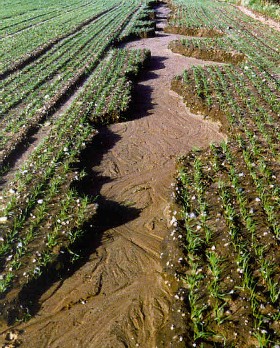

 |
What is Soil Erosion?Erosion is a major problem affecting soils all over the world. It is a process that involves the removal and transport of soil by wind and water. Whilst erosion is natural process, human activities such as changes in farming and land management practices, can cause it to occur much faster than under natural conditions. The rapid growth of the world’s population has resulted in increased cultivation of land. This puts more pressure on land and leads to soil losing its structure and cohesion, which means that it can be eroded more easily. Heavy farming machinery can also ‘compact’ soil, which causes water to run straight off the surface after rain, taking soil particles with it, instead of infiltrating into the soil. Changes in farming methods are not the only ways in which humans are contributing to soil erosion; activities such as construction and even recreation, such as hill walking, have led to severe erosion. Soil scientists now have a much greater understanding of what causes erosion, and are developing new methods of land cultivation and management to control the problem. Examples of these include creating 'buffer' strips around field to catch soil as it washes off, and the use of special 'geotextile' matting where vegetation is lacking. When soils are washed away small channels (or 'rills') can form, these may get bigger - becoming 'gulleys'. Eventually, these gulleys can get so deep you can walk down into them and it may be hard to get back out (as Shere Khan found out in the 'Jungle Book' if you haven't yet read it!) |
|||

|
|||
|
|
Back to 'Preserving Soils' | ||